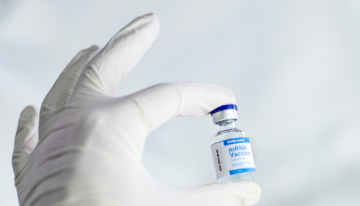
 Written by Erik Lamoureux, PhD Student in Mechanical Engineering, Multi-Scale Design Lab (Ma Lab) at the Centre for Blood Research (left)
Written by Erik Lamoureux, PhD Student in Mechanical Engineering, Multi-Scale Design Lab (Ma Lab) at the Centre for Blood Research (left)
Edited by Sarah Bowers, PhD Student in Microbiology and Immunology, Brown Lab at BC Children’s Hospital Research Institute (right)
The way we go about our daily lives has changed drastically as a result of the COVID-19 pandemic. Universities transitioned to online learning, music concerts and festivals were cancelled, and businesses operated at a reduced capacity. We continue to physically distance, wash our hands, and wear masks to reduce viral spread. To protect against COVID-19, vaccines have been widely successful, with the director of the US Centers for Disease Control and Prevention describing ongoing outbreaks as a “pandemic of the unvaccinated”1. The success of vaccines is illustrated here in Canada, where those who are fully vaccinated accounted for only 4.0% of cases, 3.2% of hospitalizations, and 4.4% of deaths between 14 December 2020 and 18 September 20212.
To date, Health Canada has approved four COVID-19 vaccines developed by either AstraZeneca/COVIDSHIELD, Johnson & Johnson, Moderna, or Pfizer-BioNTech. Whereas the AstraZeneca and Johnson & Johnson vaccines are delivered in viral-vectors, a traditional vaccine technology developed in the 1970s3, the Moderna and Pfizer-BioNTech vaccines are messenger RNA (mRNA) vaccines4. Although the concept of mRNA vaccines has been studied for decades, these COVID-19 vaccines are the first mRNA vaccines ever approved. If you are one of over 75% of Canadians who have received at least one dose of vaccine so far5, you likely received one of these mRNA vaccines.

“In addition to being widely successful for addressing COVID-19, mRNA vaccines are being tested for other infectious agents such as Ebola, Zika virus, influenza, and even malaria”
So, how do they work? For these vaccines, lipid nanoparticles surrounding the mRNA allow for penetration into cells. Once inside, the mRNA then provides instructions for cells to produce proteins that are unique to the virus, such as the spike protein. The presence of the spike protein results in an immune response against the perceived infection and elicits a memory response against the spike protein to fight off future infections with the same virus. Vaccines designed in this way have multiple advantages over traditional technologies, including viral vector vaccines. Since mRNA is relatively easy to make in a lab in large quantities, candidate mRNA vaccines can be chemically synthesized in under a week, requiring only knowledge of the sequence encoding virus-specific proteins and necessary manufacturing capacity. As such, an mRNA COVID-19 vaccine underwent animal testing only weeks after the COVID-19 genetic code was made public, resulting in an approved vaccine 11 months later6.
In addition to being widely successful for addressing COVID-19, mRNA vaccines are being tested for other infectious agents such as Ebola, Zika virus, influenza, and even malaria7, 8. Traditionally, malaria vaccine development has been underfunded and hindered by the complexity of the malaria parasite and its life cycle. Malaria has extensive antigenic variation, and there remains a poor understanding of the interaction between the malaria parasite and the human immune system8. The RTS,S malaria vaccine, which was developed in 1987 and approved by the European Medicines Agency in 2015, is the first licensed vaccine for use against a human parasitic disease. However, it requires three or four doses to achieve an efficacy of around 30% in infants and children9, a group in desperate need of protection. While a new malaria vaccine, R21/Matrix-M, has a reported efficacy of 75%, it has yet to be approved10, 11. All considered, it is evident that developing a vaccine to combat a single-cell pathogen like malaria is difficult.
Despite these challenges, there is reason to believe that an mRNA vaccine could lead to production of proteins central to the functioning of the pathogen and provide a strong protective immune response. This is the view of BioNTech, the German biotechnology company partnered with Pfizer to produce one of the COVID-19 mRNA vaccines. BioNTech is committed to developing an mRNA vaccine for malaria and is aiming for clinical trials by 202211. Crucially, there is evidence to support the putative utility of an mRNA vaccine against malaria. Recent results published in npj Vaccines suggest that an mRNA lipid nanoparticle vaccine platform could be protective against malaria in mice12. The researchers used lipid nanoparticle-coated mRNA expressing the immunodominant coat protein of the invasive stage of the malaria parasite, circumsporozoite protein, as an antigen to assess the immunogenic and protective potential of the vaccine. These authors argued that an additional benefit of the mRNA platform is that it is conducive to optimization and refinement, potentially leading to improved mRNA stability, half-life, increased protein production, and increased interactions between the antigen and immune system12.
Overall, mRNA vaccines have been tremendously successful in combating COVID-19, both in terms of efficacy and speed of development. As the technology and production pipeline of mRNA vaccines matures, there is promise for the development of a highly effective mRNA malaria vaccine in the next few years.
Addendum: On 6 October 2021, the World Health Organization recommended widespread use of the RTS,S malaria vaccine among children in sub-Saharan Africa and in other regions with moderate to high malaria transmission. Read more about this historic announcement.
Erik Lamoureux graduated in 2019 with a Bachelor of Applied Science (BASc) degree from UBC in Mechanical Engineering, Biomedical Engineering Option. After two years in the MASc program at UBC, he transferred to the PhD program, also in Mechanical Engineering.
References
1 Andone, D. & Holcombe, M. COVID-19 ‘is becoming a pandemic of the unvaccinated,’ CDC director says. CTV News. 16 July 2021. https://www.ctvnews.ca/health/coronavirus/covid-19-is-becoming-a-pandemic-of-the-unvaccinated-cdc-director-says-1.5512045
2 COVID-19 daily epidemiology update. Government of Canada. 27 Sept 2021. https://health-infobase.canada.ca/covid-19/epidemiological-summary-covid-19-cases.html
3 Viral Vector Vaccines. Centers for Disease Control and Prevention. 13 Apr 2021. https://www.cdc.gov/coronavirus/2019-ncov/vaccines/different-vaccines/viralvector.html?CDC_AA_refVal=https%3A%2F%2Fwww.cdc.gov%2Fvaccines%2Fcovid-19%2Fhcp%2Fviral-vector-vaccine-basics.html
4 mRNA Vaccines. Centers for Disease Control and Prevention. 04 Mar 2021. https://www.cdc.gov/coronavirus/2019-ncov/vaccines/different-vaccines/mRNA.html
5 COVID-19 vaccination in Canada. Government of Canada. 24 Sept 2021. https://health-infobase.canada.ca/covid-19/vaccination-coverage/
6 Why are mRNA vaccines so exciting? Harvard Health Publishing. 10 Dec 2020. https://www.health.harvard.edu/blog/why-are-mrna-vaccines-so-exciting-2020121021599
7 mRNA Vaccine Yields Full Protection against Malaria in Mice. Walter Reed Army Institute of Research. 20 Jun 2021. https://www.wrair.army.mil/node/646
8 Crompton, P. D., Pierce, S. K., & Miller, L. H. (2010). Advances and challenges in malaria vaccine development. The Journal of Clinical Investigation, 120(12), 4168–4178. https://doi.org/10.1172/JCI44423
9 RTS,S Clinical Trials Partnership. (2015). Efficacy and safety of RTS,S/AS01 malaria vaccine with or without a booster dose in infants and children in Africa: final results of a phase 3, individually randomised, controlled trial. The Lancet, 386(9988), 31-45. https://doi.org/10.1016/S0140-6736(15)60721-8
10 Moorthy, V. & Binka, F. (2021). R21/Matrix-M: a second malaria vaccine? The Lancet, 397(10287), 1782-1783. https://doi.org/10.1016/S0140-6736(21)01065-
11 From COVID to malaria: The potential of mRNA vaccines. Deutsche Welle. 29 July 2021. https://www.dw.com/en/from-covid-to-malaria-the-potential-of-mrna-vaccines/a-58694888
12 Mallory, K. L., Taylor, J. A., Zou, X. et al. (2021). Messenger RNA expressing PfCSP induces functional, protective immune responses against malaria in mice. npj Vaccines, 6(84). https://doi.org/10.1038/s41541-021-00345-0


